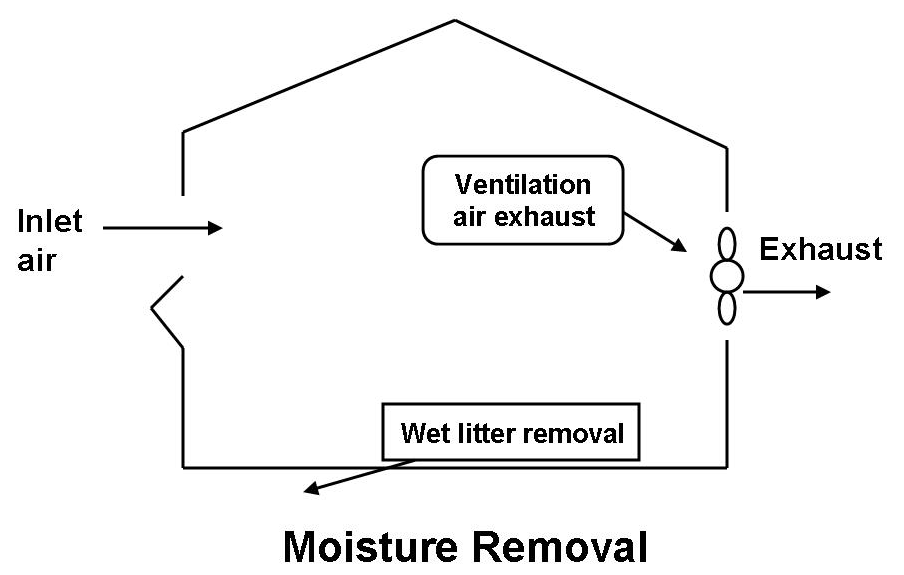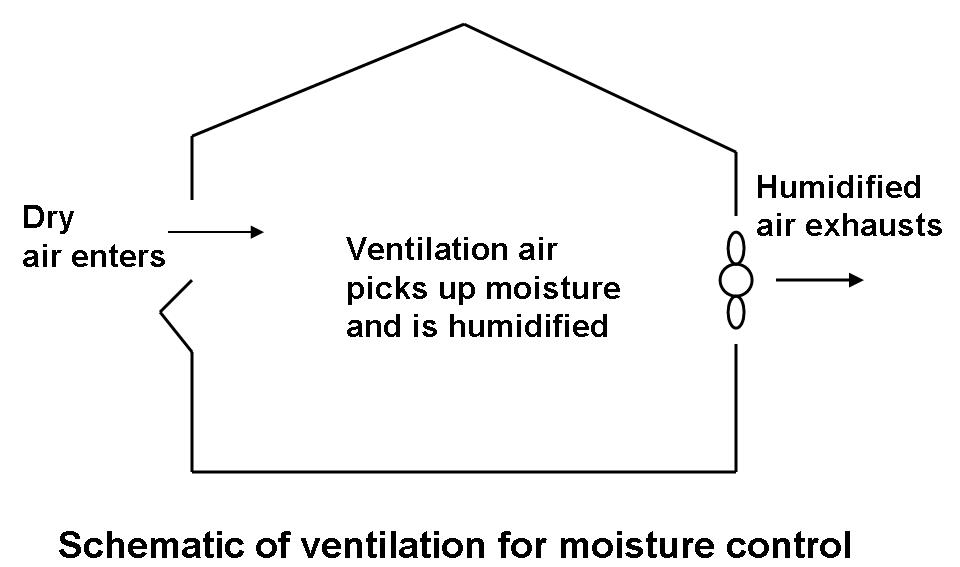Chapter 7 - Air Exchange for Moisture Control
Chapter 7 - Air Exchange for Moisture Control
Litter moisture and indoor relative humidity control is very important in poultry facilities. Wet litter can contribute to feet and leg problems and increased ammonia production. High relative humidities can contribute to condensation and frost on walls, ceilings and around the perimeter. The relationship between temperature and the air’s moisture holding capacity of the outdoor and indoor temperatures play an important role in moisture control for air exchange. A key element of the relationship is that warmer air has a greater holding capacity (see Figure 7.6). This means that when the temperature difference between inside and outside is large the air has a larger capacity to remove moisture from the poultry house. When the temperature difference between inside and outside air is small, the air has a smaller capacity to remove moisture from the barn. As a rule of thumb, the moisture holding capacity of saturate air doubles for every 20°F temperature rise.
Figure 7.6 - The relationship between temperature and water-holding capacity of air

Air exchange achieved through ventilation is used to remove the moisture in respired air and excreted feces from the chickens. Ventilation must also remove water spilled or leaking from drinkers. Moisture sources and methods of removal are illustrated in Figure 7.7.
Figure 7.7 - Moisture sources and removal in poultry houses


As illustrated in Figure 7.8, relatively cool and dry outdoor air is brought into the poultry house. The air is warmed increasing the air’s moisture holding capacity. Liquid water is evaporated. The evaporated water vapor and respired moisture from the chickens is absorbed into the air increasing its humidity ratio. The warm, moisture-laden air is exhausted from the building and replaced with more cool and dry outdoor air and the process is repeated.

In cold weather, to conserve heat, the minimum air exchange is often used. The minimum air exchange required must be sufficient to control moisture conditions in the poultry house. Much less outdoor air is needed in cold weather because of the large temperature and moisture holding capacity that occurs when the outdoor air is warmed. In spring and fall, the temperature difference between inside and outside is much smaller which means that there is much less of an increase in the air’s moisture holding capacity. If the outdoor air is warm and moist (i.e., it has a high dew-point temperature and high humidity ratio) it is even harder to maintain litter moisture conditions.
In warm weather moisture control is fairly easy to accomplish because of the large moisture holding capacity of the warm air. In hot and humid weather, however, heat stress can be a problem because the broilers have a difficult time getting rid of their body heat. The air’s high humidity ratio and dew-point temperature do not allow the broilers to lose much heat by evaporation in their respiratory system.
Ventilation is an important factor in litter moisture control. Ventilation air exchange is used to remove moisture produced within the building. Excessive air exchange can remove too much moisture and produce dry dusty conditions. Insufficient air exchange removes too little moisture and produces wet litter conditions. Litter dries faster when the air’s moisture holding capacity (based on indoor conditions) is large and the outside air’s humidity is low. This condition exists in cold weather when the outside air is heated when it enters the building.
